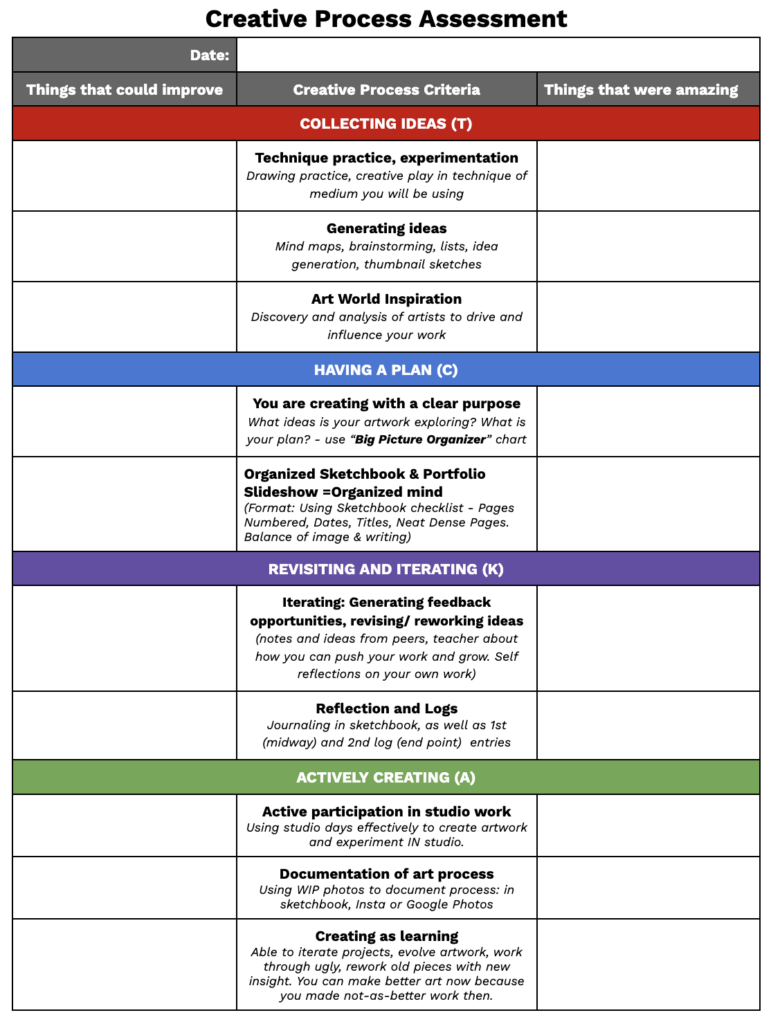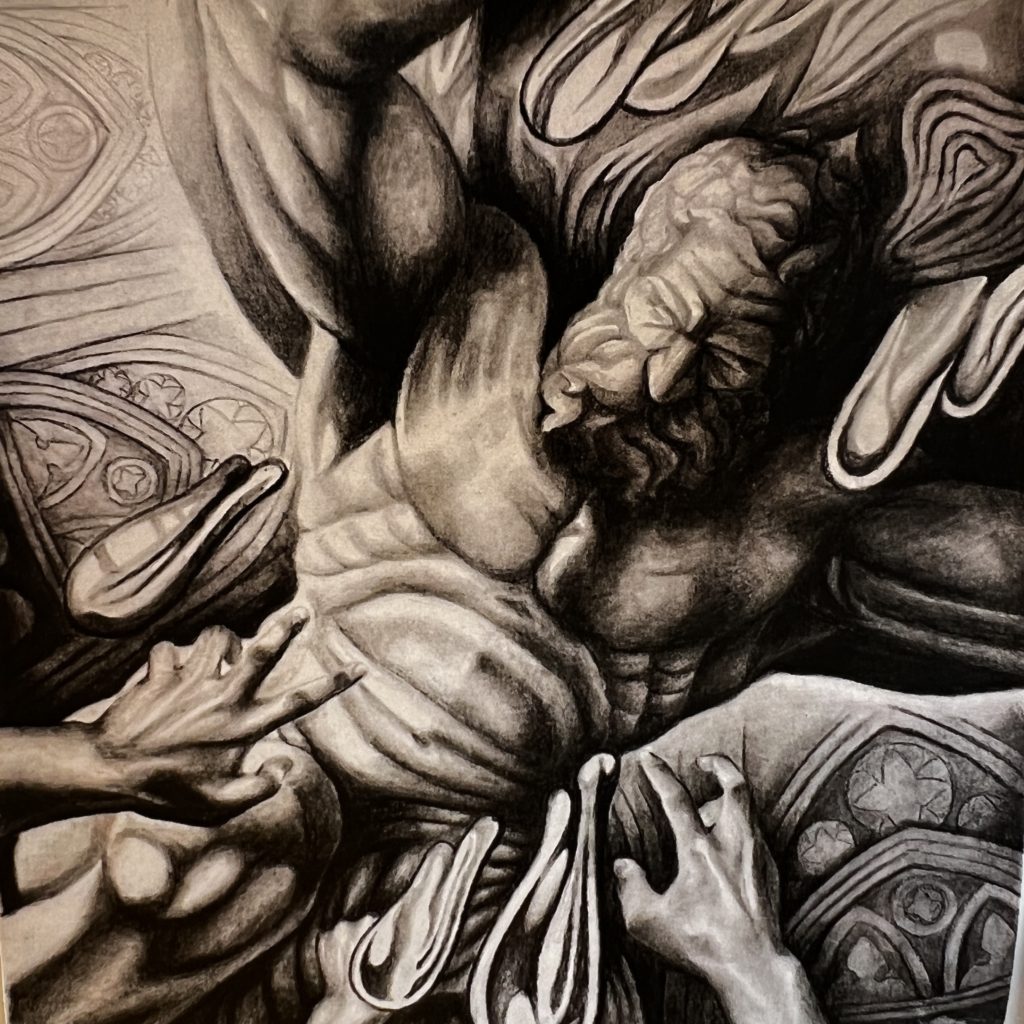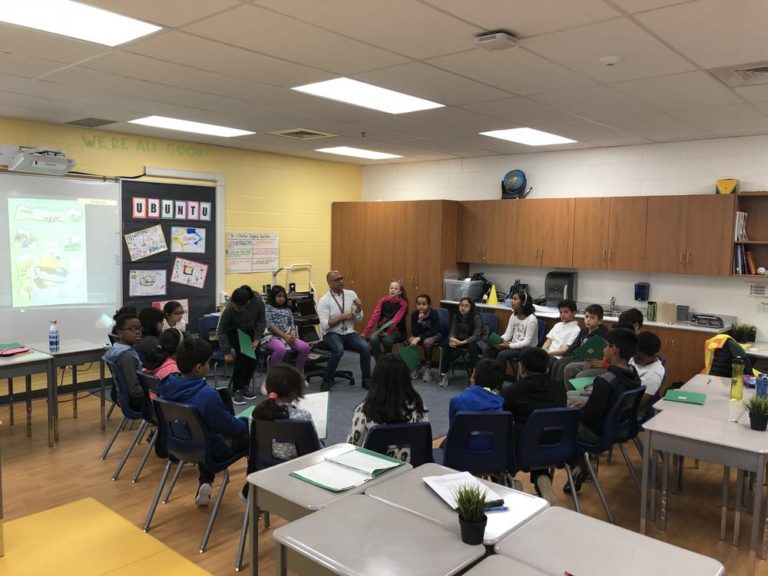Jennifer Smallwood is an art and drama teacher at Dr. Frank J. Hayden Secondary School. She has started on the journey of ungrading her classes, starting with her Grade 12 Art class in September 2021. Here is what she had to share after running her first class “ungraded”.

I made the decision to try ungrading in my classes because I was finding that I was having too many conversations with students about percentages and marks rather than the actual creation of their artworks. We have been on a journey in the department for a number of years rethinking the assessment and evaluation process to emphasize creativity, experimentation, the creative process, and to de-emphasize the final product. Going almost fully gradeless felt like the natural progression in that process. I think it really hit home when I saw my own son start high school. As a parent, I could see him playing the game of school, actively seeking to find out what each teacher was looking for in order to maximize his marks, rather than focus on his own learning. That was the point that it really started to hit home what was at stake for all high school students.
In my (ungraded) classroom
If you were to pop into my ungraded art classroom this past semester, it would definitely look busy. There are a wide variety of materials everywhere, a buzz of activity, and a lot of chatter. If you take a closer listen, the chatter is filled with feedback and productive conversations happening all the time. In fact, that was one comment I heard again and again from students in their end of the course surveys, that they appreciated the feedback from their peers which allowed them to consider other choices and to grow as artists. The course is really centred on how they are working through the creative process. What I’ve noticed after a semester of learning in this style, is that students are making a lot more considered choices about their work. They are conscious of the choices they are making and they are capable of manipulating those choices. There are also a lot more meaningful exchanges between students, which delighted me. One question I asked at the end of the course was “what was the most meaningful feedback you received this semester” and every single student chose feedback that had been given to them by their peers, NOT me as the instructor. I felt like that was such a win, and a groundswell shift in the dynamics of the class. In previous years, I felt students really relied on my feedback to drive their work forward.

Gr 12 Art Student in Jennifer Smallwood’s Class
Why go “ungraded”?
When I made the decision to go “ungraded” in class, I talked about this with my students and I really took the time to explain WHY we were doing this. I was honest and told them that I realized that my students spent the semester trying to figure out what “I wanted” or would give them the best grade, instead of making work for themselves. I asked them to think about this for a minute, as it was something I realised I did in high school too. I think that really resonated for them. From that moment on, the entire class completely bought into the concept. I have been pleasantly surprised (and a little shocked, if I’m being honest) that no students ever asked me about their grades throughout the course. Not. Once. They seemed very surprised when I brought it up at reporting times.
In terms of a learning curve, there are definitely aspects of the course that I still struggle with and will continue to tweak moving into a new semester. I found it very challenging to fit in one on one conferences with all students, which was the tool I used this past semester to come to an understanding about their mid-term mark. It takes up a lot of class time that otherwise removed me from helping all students one on one. We had great conversations in the conferences we did this past semester, but they were definitely too long. I think that I like to chat and so the amount of time each conference takes makes it difficult to squeeze everyone in. Next semester, I’m going to focus on micro-conferences – targeted conferences about only one key look for in the creative process, and with a kitchen timer holding both of us accountable to keeping it brief.
Pedagogical Documentation of Learning

Art class is a pretty fluid process. This is a grade 12 class, so in this course, students have a lot of creative licence to take their art creation in directions that they are interested in pursuing. The creative process is the central artery that runs through the course, and all investigations, explorations and provocations stem from that. We use one central document, a single point rubric, that we used to document observations throughout the course. I had a paper copy – one page per student, and I would document our discussions and take notes. This is one area that needs some growth in my practice to create better workflow. We have so many organic conversations in the art studio about students’ work and growth and it is difficult to capture all those conversations in a meaningful way. Sometimes I feel like the pedagogical documentation isn’t so much for either the student or myself, rather it is for a third party (parents, or admin for example). So I’m continuing to play with this structure, so that it is beneficial for both student and teacher, and not just for documentation purposes.

Gr 12 Art Student in Jennifer Smallwood’s Class
Reflecting and Next Steps for Ungrading
Looking back on this first semester of ungrading in my class, I have learned so much, most importantly, I see the true VALUE in it (irony intended there). Ungrading emphasizes the ideals I wanted the students to have – learning as a unique, personal journey and creativity to take risks with no spectre of grades discouraging that. I learned for myself that I talk too much and need to put myself on a timer, as individual conferences take way too long. I’m going to try that next semester: holding ourselves to a kitchen timer to do micro-conferences, hopefully that will keep us both accountable to being efficient as well as taking away the pressure to talk about every aspect of the creative process in one conference. I learned on a deeper level how working in an ungraded class really promotes good relationships, both between students and I, as well as student to student. There is a greater sense of safety in the dialogue, and the sense of community was really enhanced.
“The biggest benefit I noticed was that when you took away the idea of an objectively ‘perfect’ grade or piece, it opened up more possibilities to creative expressions of the idea you may not have gotten otherwise if we were being graded.”
~Gr12 Student
Student Voice
In surveying students at the end of the semester, 100% of students said that I should keep going with this model. They felt less stressed, felt comfortable to explore, take risks and create without the pressure of meeting project requirements. I was also pleasantly surprised in that new climate that encourages risk-taking, how much students thrived under their own creative constraints that they set for themselves – deliberately choosing to NOT work in materials they were most comfortable with, or trying new materials that they hadn’t previously considered, or working much bigger than they were used to. Without the pressure of feeling marked on everything, they felt freed to take more risks, and as a result, most students ended up in new places that they never realized they would thrive in.
“I loved the ungraded feedback! I tend to obsess over the number grade, so having that take a backseat helped to ease some of my stress, leading to more authentic and creative expressions within my art when I didn’t have to measure up to an objective standard. Despite the more relaxed and self-directed structure of the course, I didn’t find myself getting lazy. Rather, I actually noticed I worked harder to achieve the goal I had set for myself, and it forced me to consider what holds me back in the creative process. Having that knowledge helped me to improve my craft rapidly and take risks, which were rewarded through my finished pieces.”
~Gr 12 Student
LINKS:
Creative Process – Single Point Rubric (Grade 12 Art)
Drawing Single Point Rubric (Grade 9 Art)



Thank you so much for sharing this story (I found it via Jordie Burton on Twitter). I too am so interested in the idea of moving away from marks, but I’m curious about how you determined student grades if you weren’t grading individual pieces along the way. You mentioned conferencing with the students – were those spent looking at the overall expectations from the curriculum and determining where the student was at? I’m guessing there’s no way to completely move away from grades, even mid-term or final grades?
Yes, that’s correct. The ONLY time that grades came up in the course were in one in one conferences before the required reporting periods: looking at their progress overall in the course and coming to an agreement where they were at in terms of a grade. Teaching in the public system means that we are still required to put a grade on the report cards.